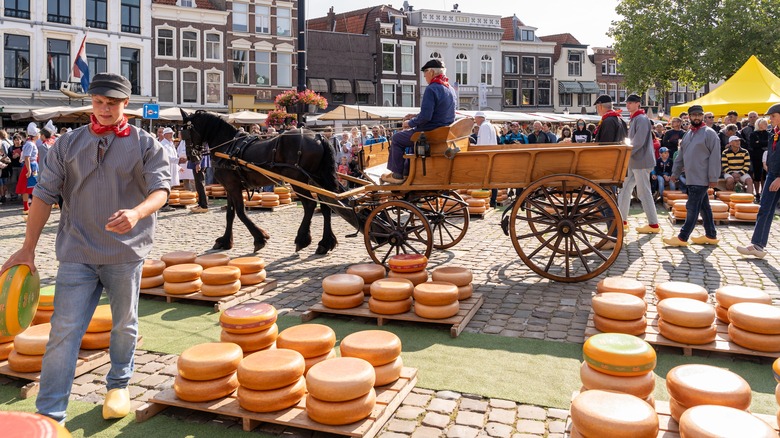Set On A Canal In South Holland Is A Charming City Famous For Cheese & Sweet Treats
Along with being a beautiful Dutch city lined with canals and medieval buildings, Gouda is a must-visit for foodies. Not only is the city named for the famous cheese produced here, but it also is the birthplace of the sweet treat called stroopwafel. With under 76,000 residents, Gouda is much smaller than Amsterdam. This charming city in the bucolic Green Heart of Holland is less than an hour from Amsterdam, 20 minutes from the lesser-known, picturesque canal city of Utrecht, and a little over two hours from Brussels. Gouda welcomes sustainable travelers, as cars are optional, bike paths are copious, traveling on the canals via stand-up paddleboards and boats is common, and it's very walkable.
In between bites of cheese and sweets, make sure to explore one of the country's largest churches, the 400-foot Sint-Janskerk, with its 72 magnificent stained-glass windows. Gouda's castle-like town hall is also noteworthy for its intricate 15th-century Gothic architecture, and the area is the perfect backdrop for the city's lively cheese market. Food lovers should also consider a trip to the beautiful Tuscan town of Pienza, famed for cheese, flowers, and unique landscapes.
Gouda's famous cheese
Gouda's namesake cheese has been inspected, weighed, and sold in the town since 1198. The Gouda Cheese Market takes place every Thursday from 10 a.m. to 12:30 p.m. from early April to the end of August. The market is a draw for visitors who come to witness large rounds of yellow cheese traded from the back of horse-drawn wagons by people wearing colorful local attire. There are also other local goods like pottery, candles, and clogs for sale. Historically, any commercial items weighing more than 10 pounds were taxed at De Goudse Waag, which now has a museum and gift shop.
For a more interactive cheese museum, visit the Gouda Cheese Experience, which is a short walk from the central train station. Here, you'll learn about how the cheese is made and have a chance to try your hand at milking a cow virtually, turning cheese, and taking photos in traditional outfits. Of course, you can also sample different varieties.
The Dutch have long been known for producing and eating cheese like gouda and edam, earning the moniker kaaskoppen meaning "cheeseheads." The waterlogged soil in the Netherlands is generally better suited to grazing livestock than farming produce, so the Dutch have been turning the milk from local cows into cheese for centuries. There are different varieties of gouda like smoked, aged (which is hard and nutty), and young gouda (which is mild, soft, and slightly sweet). The cheese base can also be enhanced by ingredients like bacon or spices like cumin.
Stroopwafels in Gouda
Gouda is also known for producing the first stroopwafel in 1810. Meaning "syrup waffle," a stroopwafel is comprised of two thin, round wafers that sandwich together a sweet, caramel-like filling. This treat is even more delicious when warm and gooey, so people often put them on top of a cup of coffee so the steam can warm the filling. The major ingredients of stroopwafels are straightforward: flour, butter, sugar, eggs, and spices. They are available in more than 85 countries and can be crumbled over ice cream or crushed and made into a pie crust to make these treats even more decadent.
While there were once 17 stroopwafel factories in Gouda, four remain today. The most famous is named after the treat's originator, Gerard Kamphuisen. You can take a 45-minute tour of the factory to see how stroopwafels are made, taste the ingredients, and sample the warm, fresh-finished product. You can even try kneading the dough. The factory is in the city center (a 10-minute walk from the train station) and is closed on Sunday. If you want to try gouda and stroopwafels in the U.S., head to Holland, Michigan, an underrated town bursting with scenic beauty and Dutch charm.


